Near-infrared light penetrates deep into your ankle tissue, where it triggers powerful healing responses at the cellular level. Your mitochondria absorb this light through a protein called cytochrome c oxidase, which boosts ATP production and cellular energy. The therapy also stimulates nitric oxide release, dilating your blood vessels and improving circulation in the swollen area. As your blood flow increases, inflammatory compounds decrease while anti-inflammatory molecules rise. You'll experience reduced swelling as the light activates tissue repair and enhances collagen production. Discover how this non-invasive treatment can be your path to faster ankle recovery.
The Science Behind Light Therapy
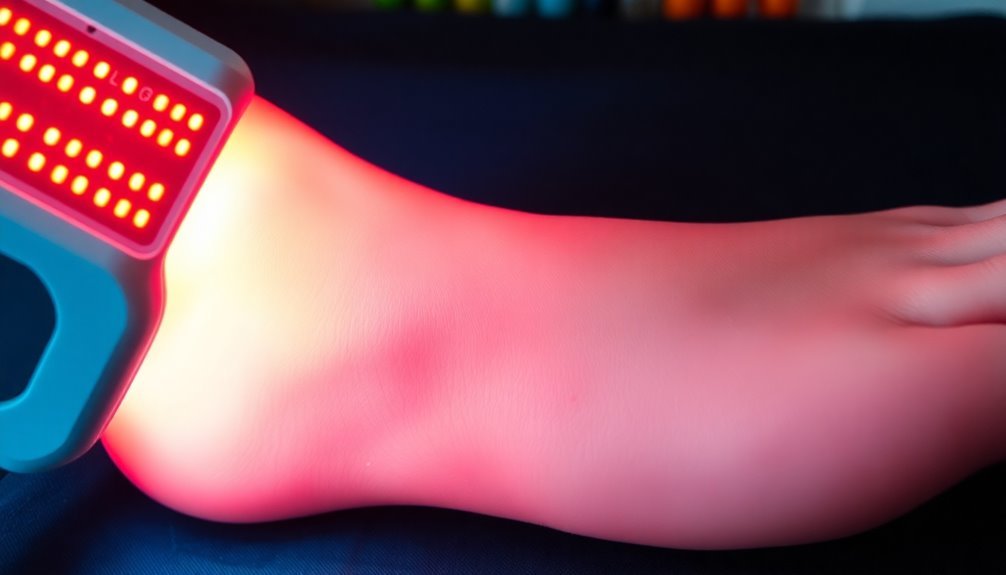
Red and near-infrared light therapy consistently proves to be a groundbreaking approach to healing and pain management. When you receive this therapy, specific wavelengths between 600 nm and 1000 nm penetrate deep into your tissues, triggering a cascade of biological responses that promote healing.
The science behind this therapy centers on how light interacts with your cells. When you're exposed to these therapeutic wavelengths, they stimulate the release of nitric oxide from your hemoglobin, which dilates your blood vessels and boosts circulation. However, clinical evidence shows that using infrared therapy as a standalone treatment offers no significant relief compared to other standard heat modalities.
Your mitochondria – the powerhouses of your cells – respond by increasing energy production, while the light also enhances collagen synthesis and cellular repair processes.
You'll find that these wavelengths create beneficial reactive oxygen species (ROS) and nitrogen oxide (NO), which influence your immune system's response. The therapy works by reducing oxidative stress and suppressing inflammatory cytokines in your body.
Through flexible pads equipped with infrared-emitting diodes, you'll receive precise wavelengths that can effectively target deeper tissues. This targeted approach helps improve tissue oxygenation and stimulates your body's natural healing mechanisms, making it particularly effective for reducing inflammation and promoting recovery.
Cellular Response to Near-Infrared Light
Your cells respond powerfully when exposed to near-infrared light, as it triggers your mitochondria to produce more energy through enhanced ATP synthesis.
You'll experience reduced inflammation because NIR light prompts your cells to decrease pro-inflammatory molecules while increasing anti-inflammatory mediators through specific cellular pathways.
The light's interaction with cytochrome c oxidase in your mitochondria leads to improved cellular function and increased ATP production, which can help reduce swelling and promote healing. NIR light's ability to penetrate deep tissue makes it more effective than UV light for treating internal swelling and inflammation.
Mitochondrial Energy Production Boost
Near-infrared light therapy substantially boosts cellular energy production by stimulating mitochondria to generate more ATP. When photons from NIR light enter your cells, they're absorbed by mitochondria, enhancing the electron transport chain activity. This process directly improves your cellular energy metabolism and overall mitochondrial function. Research shows that oxidative phosphorylation efficiency is 15 times greater than anaerobic glycolysis in producing energy.
The light therapy also triggers mitochondrial biogenesis, which means your cells create new mitochondria. This happens through the activation of regulatory proteins like AMPK and PGC-1α, ensuring a constant supply of energy-producing organelles.
You'll benefit from increased ATP production, which can improve your muscle strength, reduce fatigue, and enhance your immune system.
Specific wavelengths of NIR light, particularly 850nm and 940nm, work most effectively to stimulate your electron transport system and cytochrome c oxidase activity. When treating ankle swelling, these wavelengths penetrate between 0.5mm to 50mm into your tissue, providing non-invasive therapeutic benefits.
The continuous light exposure improves your cells' resistance to stress and enhances their metabolism, making it an effective treatment option that doesn't require medication.
Inflammation Reduction Pathways
Light-induced inflammation reduction occurs through several cellular pathways when you undergo NIR therapy. When NIR light penetrates your tissue, it triggers a cascade of cellular responses that help reduce swelling and inflammation.
You'll find that NIR exposure modulates cytokine expressions, specifically decreasing pro-inflammatory cytokines like IL-1β and IL-18 while increasing anti-inflammatory cytokine IL-10. NIR therapy has demonstrated impressive results, with studies showing it can achieve up to 80% reduction in inflammatory cytokine secretion.
The therapy works through a fascinating hormetic effect: NIR light initially causes a brief increase in reactive oxygen species (ROS), which then activates your body's ROS-scavenging enzymes. These enzymes ultimately lower your intracellular ROS levels, leading to reduced inflammation.
You'll also experience enhanced mitochondrial activity, as NIR stimulates the expression of respiratory genes like citrate synthase, promoting anti-inflammatory M2 macrophage polarization.
The TLR4/NF-κB inflammatory signaling pathway is another key mechanism that's influenced by NIR exposure. When you receive NIR therapy, this pathway's activity decreases in your alveolar and macrophage cells, contributing to systemic inflammation reduction.
These combined effects make NIR therapy particularly effective for reducing ankle swelling through multiple, interconnected cellular mechanisms.
ATP Synthesis Enhancement
Boosting cellular energy production lies at the heart of NIR light therapy's effectiveness for ankle swelling. When you receive NIR treatment, the light penetrates your tissue and targets cytochrome c oxidase in your cellular mitochondria. This interaction kicks off a remarkable process where photons excite electrons and break up nitric oxide bonds, making it easier for hydrogen ions to move through your cells.
You'll benefit most from wavelengths around 850nm and 940nm, as they're particularly effective at stimulating ATP production. These specific wavelengths enhance your mitochondrial function by increasing electron transport chain activity and improving cellular respiration.
When your cells produce more ATP, they're better equipped to repair damage and reduce inflammation in your swollen ankle. Studies show that NIR therapy achieves non-cytotoxic cell benefits while promoting healing.
The continuous application of NIR light works better than pulsed treatments for ATP synthesis. As your mitochondrial complexes respond to the light, they increase their electron transport capacity, leading to more efficient energy production.
This enhanced cellular energy helps your ankle tissue heal more effectively, while also improving blood flow and reducing inflammation in the affected area.
How Light Penetrates Ankle Tissue
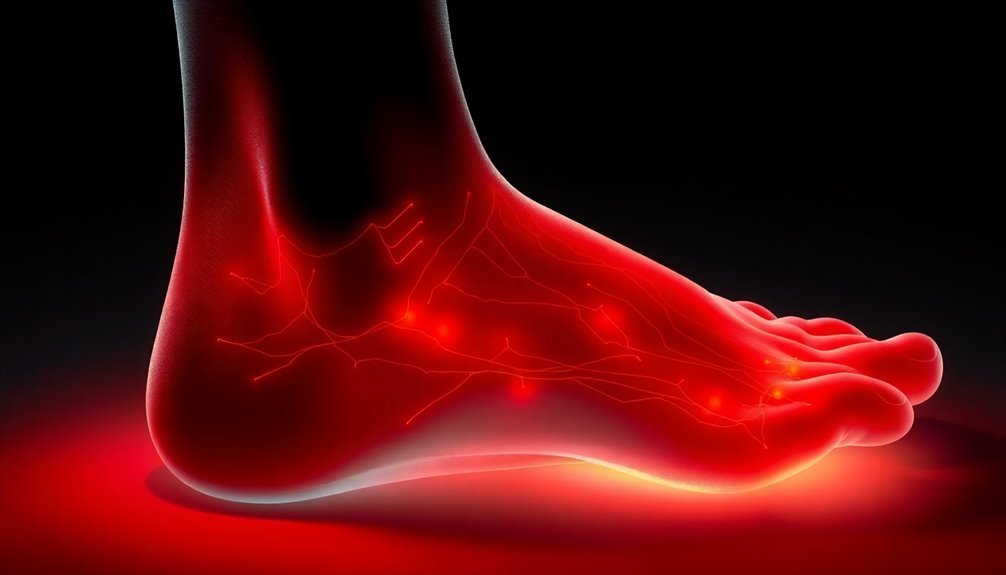
Near-infrared light penetrates your ankle tissue through wavelengths between 780 nm and 980 nm, reaching deep layers where it's absorbed by chromophores in your blood, melanin, and water.
As the light travels through different tissue layers, it interacts with cells and triggers biological processes that promote healing and reduce inflammation. The therapy works through photobiostimulation effects rather than heat-based mechanisms.
Your cells respond to this light exposure by increasing ATP production and releasing nitric oxide, which improves blood flow and supports tissue repair.
Wavelength Depth and Absorption
The ankle's complex tissue layers interact uniquely with infrared radiation, with penetration depths reaching up to 1.5 inches beneath the skin surface. When near-infrared light hits your ankle, wavelengths between 780 nm and 1500 nm penetrate most effectively, reaching deep into the musculoskeletal tissue where swelling often occurs. Red light therapy sessions lasting 5-15 minutes daily deliver optimal healing benefits for ankle injuries.
| Tissue Type | Absorption Rate | Penetration Effect |
|---|---|---|
| Skin Surface | High | Immediate heating |
| Blood Vessels | Moderate | Vasodilation |
| Deep Tissue | Gradual | Long-lasting relief |
You'll find that the absorption process happens in distinct phases. First, the IR radiation triggers local vasodilation in your ankle's blood vessels through histamine release. Then, you'll notice visible redness (erythema) as your vessels expand. The penetration depth isn't just about wavelength – it's affected by your tissue density, skin pigmentation, and the angle of the IR source. Shorter wavelengths in the near-IR range penetrate deeper than longer ones, making them more effective for treating deep ankle swelling. While some IR rays scatter or reflect off your skin's surface, enough reach the deeper tissues to stimulate healing and reduce inflammation through increased circulation and oxygen delivery.
Tissue Layer Interactions
Light penetrates ankle tissue through a fascinating cascade of interactions, starting with the epidermis and working its way into deeper structures. As near-infrared (NIR) light moves through your skin layers, it's absorbed by specific cellular components, particularly cytochrome c oxidase, which acts as a chromophore in your tissue cells.
When NIR reaches your ankle's deeper tissues, it triggers multiple healing mechanisms. You'll find that the light modifies cell membrane potentials and increases intracellular calcium levels, while simultaneously promoting nitric oxide synthesis. The therapy uses specific wavelengths between 600-1000nm to achieve optimal cellular response.
These actions improve blood circulation and enhance tissue repair in your ankle region.
What's particularly effective about NIR light is that it penetrates deeply with minimal thermal effects on your skin and fat layers. Instead, it focuses its therapeutic impact on the underlying muscle and connective tissues where swelling often occurs.
The light's interaction with your cells stimulates ATP production, reduces oxidative stress, and initiates a series of cellular responses that combat inflammation. This process is especially beneficial for ankle swelling because it enhances fibroblast activity and collagen production, accelerating the healing of injured tissues while reducing pain and inflammation.
Cellular Response to Light
Understanding cellular response to light starts at the microscopic level, where photons interact with specific components in your cells. When near-infrared light penetrates your ankle tissue, it triggers a series of reactions in your cellular machinery, particularly in the mitochondria and cytochrome c oxidase.
These interactions boost your cells' energy production through increased ATP levels and enhance blood vessel dilation through nitric oxide release.
Your cells respond to this light therapy through three primary mechanisms:
- Enhanced ATP production: The light energy stimulates your mitochondria to produce more ATP, giving your cells the extra energy they need for tissue repair and reducing inflammation.
- Improved circulation: Blood vessels dilate, allowing more oxygen and nutrients to reach the injured area while removing waste products that contribute to swelling.
- Accelerated healing: The light energy stimulates fibroblasts to produce more collagen, while also increasing cell membrane permeability for better nutrient absorption.
This cellular response creates an ideal healing environment in your ankle tissue, reducing inflammation and swelling while promoting tissue repair. The process doesn't generate heat, making it a safe and effective treatment option for ankle swelling.
Treatment Methods and Best Practices
Modern applications of near-infrared radiation have revolutionized ankle swelling treatment protocols. You'll find that successful treatment requires following specific timing and application methods. For ideal results, you'll need to apply near-infrared therapy twice daily, with sessions lasting 5-30 minutes depending on injury severity.
To maximize the therapy's effectiveness, you should maintain consistent treatment even after initial pain reduction. You can use home devices to integrate the therapy into your daily routine, making it easier to stick to the recommended protocol. The treatment's non-invasive nature means you won't need drugs or surgery.
| Treatment Phase | Duration | Key Focus |
|---|---|---|
| Acute | 5-10 minutes | Reduce swelling |
| Intermediate | 10-20 minutes | Improve circulation |
| Maintenance | 15-30 minutes | Tissue repair |
| Prevention | 10-15 minutes | Strengthen tissue |
When applying the therapy, guarantee direct exposure to the affected area. You'll notice reduced swelling as the near-infrared light stimulates nitric oxide production and enhances blood flow. Remember that while some patients see quick improvements, others might need extended treatment periods based on their injury's severity.
Clinical Evidence and Research Results
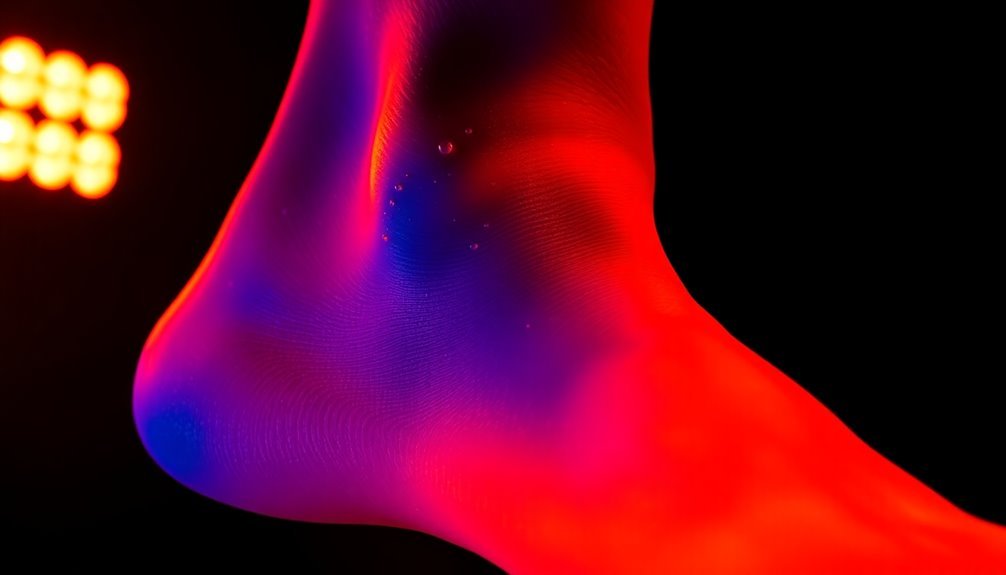
Extensive clinical research validates the effectiveness of near-infrared radiation therapy for ankle swelling. Clinical trials have demonstrated that NIR therapy substantially reduces pain and inflammation while promoting faster healing in musculoskeletal conditions.
You'll find that studies using devices like the StarLux-IR Deep Dermal have shown pain reductions ranging from 40% to 100%, with patients experiencing long-lasting relief that allows them to resume normal activities.
The research highlights three key mechanisms that make NIR therapy effective for ankle swelling:
- Deep tissue penetration triggers localized heating, which increases blood flow and promotes natural anti-inflammatory responses
- Enhanced mitochondrial function boosts cellular energy production, leading to improved tissue repair and reduced inflammation
- Increased production of endorphins and improved nerve conduction velocity helps manage pain through natural pathways
While some studies note variations in treatment protocols and intervals, the overall evidence consistently supports NIR therapy's effectiveness. Blind studies comparing actual and sham treatments have confirmed these benefits, though it's worth noting that swelling reduction results can vary among patients.
The therapy's safety profile remains strong, with no noteworthy complications reported during or after treatments.
Therapeutic Benefits for Athletes
Athletes' growing adoption of near-infrared radiation therapy has revolutionized sports medicine approaches to ankle swelling. This therapy accelerates healing through multiple mechanisms, primarily by increasing nitric oxide production and enhancing blood circulation to your injured ankle.
When you're dealing with ankle swelling, near-infrared radiation offers several key benefits. It'll stimulate your lymphatic system to drain excess fluid more efficiently while promoting collagen production for stronger tissue repair.
You won't just experience reduced swelling; you'll also notice decreased muscle tension and improved pain management without relying on medications.
You can expect faster recovery times with consistent use of this therapy. Sessions typically last 5-15 minutes, and you can easily incorporate them into your training routine. Whether you're at home or in a clinical setting, you'll have access to portable devices that make treatment convenient and flexible.
The therapy's versatility means you can use it alongside other treatments to enhance your recovery. You'll benefit from improved cellular energy production and reduced oxidative stress, which together create ideal conditions for healing.
This thorough approach helps you return to full activity sooner while maintaining tissue health.
Managing Pain Through Light Therapy
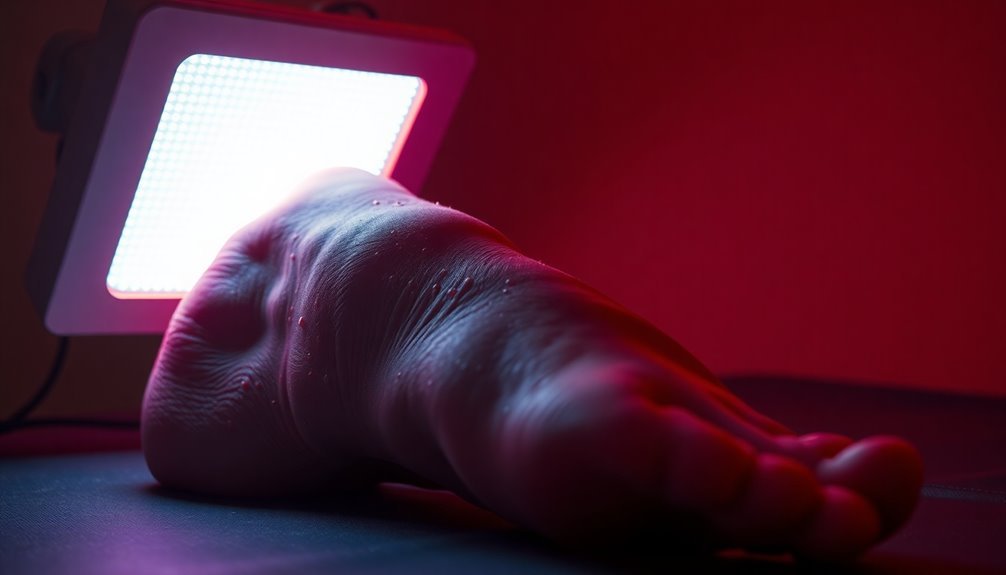
Light therapy pioneers a new frontier in pain management for ankle swelling, offering you a drug-free alternative that targets discomfort at its source. When you receive near-infrared light therapy, it works through photobiomodulation, triggering cellular responses that reduce inflammation and accelerate healing in your injured ankle tissues.
During treatment, you'll experience light penetrating your skin through various mechanisms including transmission and absorption. The light interacts with chromophores in your cells' mitochondria, kickstarting a healing cascade that produces nitrous oxide, improving blood flow to the affected area.
Your treatment sessions will typically last 5-10 minutes, with pain relief occurring either immediately or within several hours.
You'll benefit from light therapy's ability to reduce inflammation while simultaneously promoting tissue repair and cellular regeneration.
Your healthcare provider can combine this therapy with other treatments to decrease your reliance on pain medications.
This FDA-approved approach isn't just about managing pain – it's about healing. The red to infrared spectrum proves most effective for chronic pain, and when used early in your treatment plan, it can prevent the need for stronger pain interventions while speeding up your recovery process.
Frequently Asked Questions
How Long Does It Take to See Results From Near-Infrared Therapy?
You'll notice pain relief within hours of your first near-infrared treatment. The benefits can last weeks or months, and you'll see significant improvements after just one or two sessions of therapy.
Can Near-Infrared Therapy Be Used Alongside Other Ankle Treatments?
Yes, you can safely combine near-infrared therapy with other ankle treatments. It'll enhance your recovery when used alongside physical therapy, shockwave therapy, or other modalities, creating better results for pain relief and healing.
Are There Any Side Effects of Using Near-Infrared Therapy?
You'll need to watch for potential side effects like skin irritation, blisters, or headaches. If you're on medications like antibiotics or tretinoin, you might experience increased sensitivity. Always wear protective goggles during treatment.
Does the Severity of Ankle Swelling Affect Treatment Success?
Yes, your ankle swelling's severity does impact treatment success. While near-infrared light therapy works for all levels, you'll need more frequent sessions for severe swelling compared to mild or moderate cases.
How Often Should Near-Infrared Therapy Be Repeated for Chronic Ankle Issues?
You'll need daily 5-15 minute sessions for several weeks to address chronic ankle issues. Aim to maintain consistent treatments every 2-3 days after initial improvement, adjusting frequency based on your response.
In Summary
You'll find near-infrared radiation effectively reduces ankle swelling through several key mechanisms. It penetrates deep into your tissue, stimulating blood flow and lymphatic drainage while activating cellular repair processes. By triggering mitochondrial function, it helps your cells produce more energy for healing. When you're using NIR therapy regularly, you'll experience decreased inflammation, faster recovery times, and improved joint mobility in your ankle area.

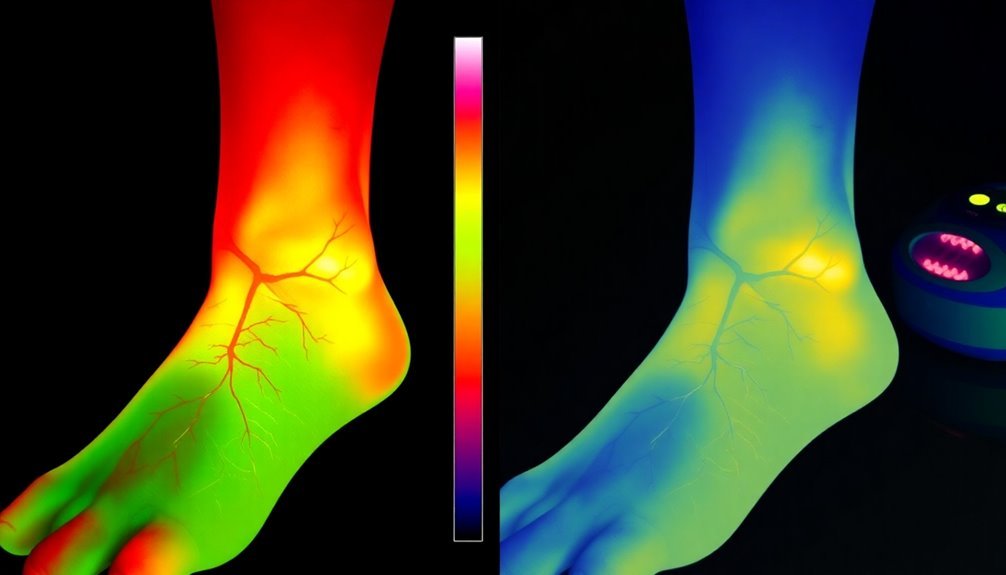



Leave a Reply